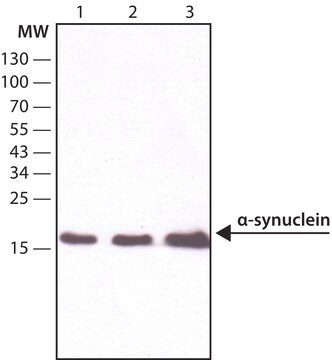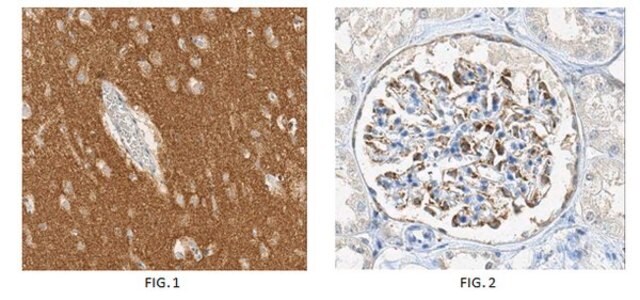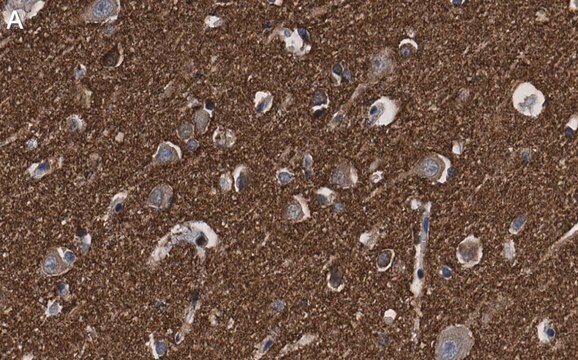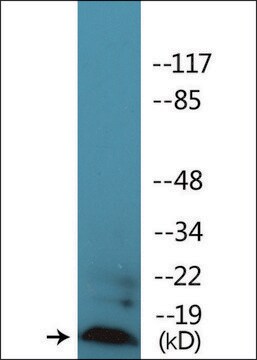MABN389
Anti-Aggregated a-Synuclein Antibody, clone 5G4
clone 5G4, from mouse, purified by affinity chromatography
Sinónimos:
Aggregated a-synuclein, Alpha-synuclein, Non-A beta component of AD amyloid, Non-A4 component of amyloid precursor, NACP
About This Item
Productos recomendados
origen biológico
mouse
Nivel de calidad
forma del anticuerpo
affinity purified immunoglobulin
tipo de anticuerpo
primary antibodies
clon
5G4, monoclonal
purificado por
affinity chromatography
reactividad de especies
human
técnicas
ELISA: suitable
immunohistochemistry: suitable
western blot: suitable
isotipo
IgG1κ
Nº de acceso NCBI
Nº de acceso UniProt
Condiciones de envío
dry ice
modificación del objetivo postraduccional
unmodified
Información sobre el gen
human ... SNCA(6622)
Descripción general
Pepscan epitope mapping experiments showed that the epitope of 5G4 seems to be hidden inside full-length a-synuclein in aqueous solution, and this fact could depend on a specific conformation of the molecule. Thus, after conformational change, like b-sheet building, the binding structure of 5G4 may be accessible in biological samples.
This antibody can be used as a sandwich ELISA pair with Cat. No. MABN633, Anti-a-Synuclein, clone 10D2.
Inmunógeno
Aplicación
Neuroscience
Neurodegenerative Diseases
ELISA Analysis: A representative lot from an independent laboratory detected Aggregated a-Synuclein in a sandwich ELISA with Cat. No. MABN633, Anti-a-Synuclein, clone 5G4 (Kovacs, G. G., et al. (2012). Acta Neuropathol. 123(1):37-50.).
Calidad
Immunohistochemistry Analysis: A representative lot detected Aggregated a-Synuclein in brain tissue from a Parkinson′s disease patient.
Descripción de destino
Forma física
Almacenamiento y estabilidad
Handling Recommendations: Upon receipt and prior to removing the cap, centrifuge the vial and gently mix the solution. Aliquot into microcentrifuge tubes and store at -20°C. Avoid repeated freeze/thaw cycles, which may damage IgG and affect product performance.
Cláusula de descargo de responsabilidad
¿No encuentra el producto adecuado?
Pruebe nuestro Herramienta de selección de productos.
Opcional
Código de clase de almacenamiento
12 - Non Combustible Liquids
Clase de riesgo para el agua (WGK)
WGK 2
Punto de inflamabilidad (°F)
Not applicable
Punto de inflamabilidad (°C)
Not applicable
Certificados de análisis (COA)
Busque Certificados de análisis (COA) introduciendo el número de lote del producto. Los números de lote se encuentran en la etiqueta del producto después de las palabras «Lot» o «Batch»
¿Ya tiene este producto?
Encuentre la documentación para los productos que ha comprado recientemente en la Biblioteca de documentos.
Nuestro equipo de científicos tiene experiencia en todas las áreas de investigación: Ciencias de la vida, Ciencia de los materiales, Síntesis química, Cromatografía, Analítica y muchas otras.
Póngase en contacto con el Servicio técnico







